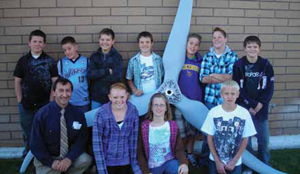How It’s Done: It’s So Easy Teaching Green

By Sascha Zuger
Most students today are taught the importance of environmental responsibility before they’re taught to tie their shoes. These lucky kids don’t just “turn to chapter seven” to get a sense of how alternative energy works. They can look out their classroom window.
A Breath of Fresh Air
The Wind for Schools (WfS) program in Idaho, Colorado, Kansas, Montana, Nebraska, and South Dakota helps coordinate the installation of small wind turbines at K–12 schools to demonstrate how wind energy works. Instruction for educators in developing hands-on STEM projects that involve the tech helps bring lessons in alternative energy home. Kids not only perform interactive research but also actually assist in the installation, in assessing the local environment, and in designing their school’s wind-energy system.
“It motivates students to apply real-world science to learning in the classroom,” says Anne Seifert, K–12 STEM coordinator at Idaho National Laboratory in Idaho Falls.


Here Comes the Sun
East Side Union High School District in San Jose, California, in cooperation with Chevron Energy Solutions, just completed the largest K–12 solarenergy- efficiency project in the country. Estimated to save the funding equivalent of the jobs of 30 teachers in the first year alone, the venture has benefits that reach beyond the financial. Educators are taking part in professional-development courses so they can create STEM-based curricula and renewable-energy experiments involving PV (photovoltaic) panels and monitors that will make students more energy conscious.
Tools and ideas to transform education. Sign up below.
“The class projects offer an understanding of what solar energy is so they can value it and see how it helps the school help the community,” says Dan Moser, superintendent of East Side Union. “They can measure it, see it, and experience the benefits.”
Fuel Cells Itself
Students on the Hamden (Conn.) High School swim team don’t revel in the July heat. Thanks to the new UTC Power 400-kilowatt fuel cell, the water in their pool is just right all year long. The electrochemical device converts hydrogen into electricity directly, and the sole exhaust is heat and water. Ninety percent of the high school’s annual electricity requirements are covered, as is heat for the school all winter, via by-product thermal energy. An energy cost savings of more than $800,000 over ten years is predicted.
***************
Whichever alternative is choen, combining renewable energy with classroom STEM curricula adds up to great chemistry.
